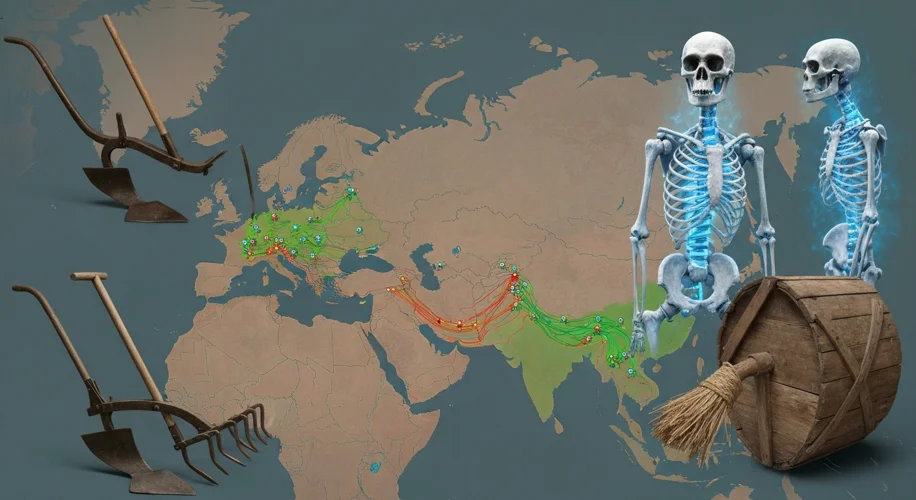For millennia, the story of agriculture has been etched into the very soil of human civilization. It’s the tale of settled life, of bountiful harvests, and the dawn of complex societies. But how did this revolutionary way of life spread from its cradles in the Fertile Crescent and East Asia to the farthest corners of the globe? For centuries, the prevailing thought was that as farming techniques emerged, they were simply adopted by neighboring communities, a ripple of innovation spreading outwards. However, the silent, powerful whispers of ancient DNA are now rewriting this narrative, revealing a much more dynamic and human story: one of migration.
Imagine a world on the cusp of profound change. Around 10,000 years ago, in regions like the Fertile Crescent, a groundbreaking discovery was being made. Humans, once nomadic hunter-gatherers, were learning to cultivate wild grains and domesticate animals. This wasn’t a sudden enlightenment; it was a gradual process, honed over generations. The shift to agriculture was monumental, providing a more stable food source, allowing populations to grow, and eventually leading to the development of villages, cities, and the complex cultures we study today.

But how did this transformative knowledge traverse vast distances? Consider the spread of agriculture across Europe. For a long time, archaeologists believed that as early farmers in Anatolia (modern-day Turkey) began cultivating crops, the knowledge and techniques were passed along the Mediterranean coast and up through the Balkan Peninsula, with local hunter-gatherer groups gradually adopting these new ways. It seemed like a logical progression of cultural diffusion, a slow adoption of a superior technology.
Then came the revolution of ancient DNA. By extracting genetic material from the skeletal remains of ancient peoples, scientists can now peer into the very blueprint of our ancestors. This genetic data, combined with archaeological evidence, paints a startlingly different picture. Instead of local populations adopting farming, the DNA tells a story of people moving. It reveals that as agriculture spread, it was largely carried by migrating groups of farmers themselves.
Think of it like this: instead of local hunter-gatherers learning to farm from a few visiting farmers, entire communities of farmers were packing up their seeds, their tools, and their livestock, and migrating into new territories. These migrants then intermingled with, and often outnumbered, the indigenous hunter-gatherer populations, bringing their farming practices with them.
This pattern is not confined to Europe. Similar DNA studies have illuminated the spread of agriculture in Asia, Africa, and the Americas. In Europe, for example, genetic studies have shown that the early farmers who moved into the continent carried distinct genetic markers that clearly differentiate them from the hunter-gatherer groups already living there. These farmers, originating from Anatolia, moved into Europe at a rapid pace, establishing agricultural settlements and fundamentally reshaping the genetic landscape. The speed of this movement, far exceeding what simple cultural adoption would suggest, points directly to large-scale migrations.
Consider the timeline: The earliest farming in the Fertile Crescent emerged around 9500 BCE. By 6000 BCE, farmers had reached the Aegean. Within a thousand years, they had spread across much of central and western Europe. This is an astonishing rate of expansion for a new lifestyle, especially one that required significant investment in land clearing and cultivation. This pace is far more consistent with people physically moving and establishing new farms than with a slow, piecemeal adoption of techniques.
What does this mean for our understanding of history? It suggests that the spread of agriculture was not just a diffusion of technology but a profound period of human movement and interaction. These migrations had immense consequences: they led to the displacement and assimilation of many hunter-gatherer populations, introduced new genetic diversity, and laid the foundation for the distinct cultures that would later emerge across continents. The very identities of ancient peoples were shaped by these movements.
This revelation challenges our assumptions about how cultural and technological change happens. It underscores the agency of people in shaping their own histories, not just by inventing new things, but by carrying them to new lands. The story of farming’s spread is, therefore, deeply intertwined with the story of human migration, a testament to our ancestors’ drive to explore, settle, and build new lives. The genetic evidence, painstakingly gathered from the bones of the past, offers a powerful and compelling narrative: we are a species on the move, and it was our feet, carrying our ancient seeds, that truly cultivated the world.

